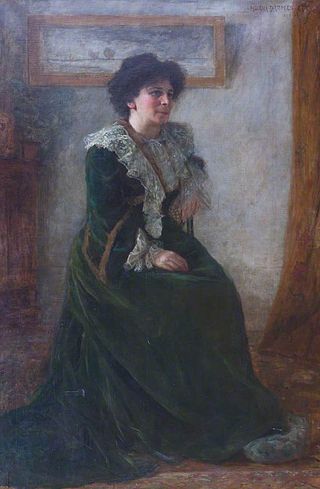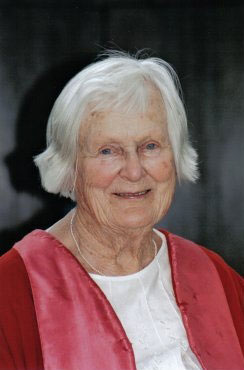
The University of Sheffield is a public research university in Sheffield, South Yorkshire, England. Its history traces back to the foundation of Sheffield Medical School in 1828, Firth College in 1879 and Sheffield Technical School in 1884. University College of Sheffield was subsequently formed by the amalgamation of the three institutions in 1897 and was granted a royal charter as University of Sheffield in 1905 by King Edward VII.

Sir Francis Darwin was a British botanist. He was the third son of the naturalist and scientist Charles Darwin.

Frederick Sydney Dainton, Baron Dainton, Kt, FRS, FRSE was a British academic chemist and university administrator.

Phoebe Sarah Hertha Ayrton was a British engineer, mathematician, physicist and inventor, and suffragette. Known in adult life as Hertha Ayrton, born Phoebe Sarah Marks, she was awarded the Hughes Medal by the Royal Society for her work on electric arcs and ripple marks in sand and water.
Muriel Clara Bradbrook (1909–1993), usually cited as M. C. Bradbrook, was a British literary scholar and authority on Shakespeare. She was Professor of English at Cambridge University, and Mistress of Girton College, Cambridge.
Moi University is a public university located in Kesses, Eldoret town, Uasin Gishu county, in the former Rift Valley Province of Kenya. It was established in 1984 by the Moi University Act of the Parliament of Kenya, after recommendations from the McKay Commission.

Sheffield Grammar School began in 1604 as "The Free Grammar School of James King of England within the Town of Sheffield in the County of York" in buildings in the Townhead area of Sheffield, resulting from the benefaction of John Smith of Crowland. In the Gazetteer and General Directory of Sheffield and Twenty Miles Round, by William White, published in 1852, the author refers to the "FREE GRAMMAR SCHOOL", noting that it "is a commodious and handsome stone building in Charlotte Street, erected by subscription in 1825, in lieu of the ancient school which stood near the top of Townhead Street. It was founded by letters patent of James I in 1604, and the Vicar and Church Burgesses are the trustees and governors".
Sheffield Collegiate School began in 1836 in new buildings on the corner of Ecclesall Road and Collegiate Crescent. The school enjoyed academic success but lacked sound finances and was taken over by Sheffield Grammar School in 1884, to become Sheffield Royal Grammar School (SRGS) in 1885.
Dame Gillian Patricia Kempster Beer, is a British literary critic and academic. She was President of Clare Hall from 1994 to 2001, and King Edward VII Professor of English Literature at the University of Cambridge from 1994 to 2002.

Phyllis Nicolson was a British mathematician and physicist best known for her work on the Crank–Nicolson method together with John Crank.
John Philipps Kenyon, FBA was an English historian and Fellow of the British Academy. His area of expertise was 17th-century England.

Sidnie Milana MantonFLS FRS was an influential British zoologist. She is known for making advances in the field of functional morphology. She is regarded as being one of the most outstanding zoologists of the twentieth century.

Dame Alice Rosemary Murray, was an English chemist and educator. She was instrumental in establishing New Hall, Cambridge, now Murray Edwards College, Cambridge, and was the first woman to hold the office of Vice-Chancellor of the University of Cambridge.
John Macnaghten Whittaker FRS FRSE LLD was a British mathematician and Vice-Chancellor of the University of Sheffield from 1953 to 1965.
Joseph Rawson Lumby (1831–1895) was an English cleric, academic and author and divine, Norrisian Professor of Divinity from 1879 and then Lady Margaret's Professor of Divinity from 1892.
The Department of Physiology, Development and Neuroscience, (PDN) is a part of the School of Biological Sciences at the University of Cambridge. Research in PDN focuses on three main areas: Cellular and Systems Physiology, Developmental and Reproductive Biology, and Neuroscience and is currently headed by Sarah Bray and William Colledge. The department was formed on 1 January 2006, within the School of Biological Sciences at the University of Cambridge from the merger of the Departments of Anatomy and Physiology. The department hosts the Centre for Trophoblast Research and has links with the Cambridge Centre for Brain Repair, the Cambridge Stem Cell Institute, and the Gurdon Institute.

Christine Mary Rutherford Fowler, is a British geologist and academic. From 2012 to 2020, she served as the Master of Darwin College, Cambridge. She was previously a lecturer at Royal Holloway, University of London, rising to become Dean of its Faculty of Science.
Mary Taylor Slow was a British physicist who worked on the theory of radio waves and the application of differential equations to physics. She was the first woman to take up the study of radio as a profession.

Agnata Frances Butler was a British classics scholar. She was among the first generation of women to take the Classical Tripos examinations at the University of Cambridge, and was the only person to be placed in the top division of the first class at the end of her third year, in 1887. She married the Master of Trinity College, Henry Montagu Butler, in August 1888, becoming the leading hostess in Cambridge. She published a version of Book VII of Herodotus' Histories in 1891.










